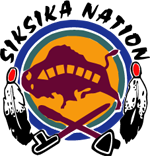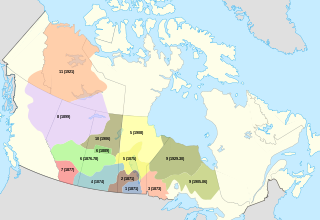Related Research Articles

The Piegan are an Algonquian-speaking people from the North American Great Plains. They are the largest of three Blackfoot-speaking groups that make up the Blackfoot Confederacy; the Siksika and Kainai are the others. The Piegan dominated much of the northern Great Plains during the nineteenth century.

The Blackfoot Confederacy, Niitsitapi, or Siksikaitsitapi, is a historic collective name for linguistically related groups that make up the Blackfoot or Blackfeet people: the Siksika ("Blackfoot"), the Kainai or Blood, and two sections of the Peigan or Piikani – the Northern Piikani (Aapátohsipikáni) and the Southern Piikani. Broader definitions include groups such as the Tsúùtínà (Sarcee) and A'aninin who spoke quite different languages but allied with or joined the Blackfoot Confederacy.

The Kainai Nation is a First Nations band government in southern Alberta, Canada, with a population of 12,800 members in 2015, up from 11,791 in December 2013.

The Blackfoot language, also called Siksiká, often anglicised as Siksika, is an Algonquian language spoken by the Blackfoot or Niitsitapi people, who currently live in the northwestern plains of North America. There are four dialects, three of which are spoken in Alberta, Canada, and one of which is spoken in the United States: Siksiká (Blackfoot), to the southeast of Calgary, Alberta; Kainai, spoken in Alberta between Cardston and Lethbridge; Aapátohsipikani, to the west of Fort MacLeod which is Brocket (Piikani) and Aamsskáápipikani, in northwestern Montana. The name Blackfoot probably comes from the blackened soles of the leather shoes that the people wore.

The Siksika Nation is a First Nation in southern Alberta, Canada. The name Siksiká comes from the Blackfoot words sik (black) and iká (foot), with a connector s between the two words. The plural form of Siksiká is Siksikáwa. The Siksikáwa are the northernmost of the Niitsítapi, all of whom speak dialects of Blackfoot, an Algonquian language.

The Pi'ikanni Nation is a First Nation, representing the Indigenous people in Canada known as the Northern Piikani or simply the Peigan.

Treaty 7 is an agreement between the Crown and several, mainly Blackfoot, First Nation band governments in what is today the southern portion of Alberta. The idea of developing treaties for Blackfoot lands was brought to Blackfoot chief Crowfoot by John McDougall in 1875. It was concluded on September 22, 1877, and December 4, 1877. The agreement was signed at the Blackfoot Crossing of the Bow River, at the present-day Siksika Nation reserve, approximately 75 km (47 mi) east of Calgary, Alberta. Chief Crowfoot was one of the signatories to Treaty 7. Another signing on this treaty occurred on December 4, 1877, to accommodate some Blackfoot leaders who were not present at the primary September 1877 signing.

Nose Hill Park is a natural park in the northwest quadrant of Calgary, Alberta which covers over 11 km2 (4.2 sq mi). It is the fourth-largest urban park in Canada, and one of the largest urban parks in North America. It is a municipal park, unlike Fish Creek, which is a provincial park. It was created in 1980.

Bearspaw is rural area in southern Alberta, Canada in Rocky View County. It has a population of 5,567 (2018).

Calgary is a city in the Canadian province of Alberta. It is the largest city in Alberta and the largest metro area within the three Prairie Provinces region. As of 2021, the city proper had a population of 1,306,784 and a metropolitan population of 1,481,806, making it the third-largest city and fifth-largest metropolitan area in Canada.
Alberta Health Services (AHS) is the single health authority for the Canadian province of Alberta and the "largest integrated provincial health care system" in Canada. Headquartered in Edmonton, AHS delivers medical care on behalf of the Government of Alberta's Ministry of Health. It operates 850 facilities throughout the province, including hospitals, clinics, continuing care facilities, mental health facilities and community health sites, that provide a variety of programs and services. AHS is the largest employer in the province of Alberta. In 2019, AHS served 4.3 million Albertans with a staff of 125,000 staff and 10,000 physicians, and an annual budget of $15.365 billion. Mauro Chies is the interim President and CEO of AHS and reports to Dr. John Cowell, the AHS Official Administrator. The Official Administrator is accountable to the Minister of Health and the Premier.
Blackfoot Trail is a super-4 expressway in Calgary, Alberta. It is named for the Blackfoot Confederacy, and more specifically the Siksika Nation, located east of Calgary. The road runs from 17 Avenue SE in the north, where Blackfoot Trail meets Deerfoot Trail, to Southland Drive in the south. It is the historical alignment of Highway 2 in south Calgary. The section of Blackfoot Trail between 19 Street SE and Deerfoot Trail is a former alignment, and still technically part of, 17 Avenue SE; however, it is generally referred to as being part of Blackfoot Trail.

Old Sun Community College is a community college owned and operated by First Nations that provides post-secondary education and training in Siksika 146, Alberta, Canada to members of the Siksika Nation.
Ben Calf Robe was a Blackfoot (Siksika) elder, residential school survivor, and scout for the North West Mounted Police.
Rilee Many Bears is a Canadian-born First Nations runner from Siksika Nation, Alberta, a part of the Blackfoot Confederacy. Many Bears, now 22 years of age, was presented with the name Iinomaahka, meaning Running Buffalo, during a naming ceremony while the Siksika Nation celebrated his achievements in running.
Making Treaty 7 is an arts collective that stemmed from the Calgary's nomination as one of the Cultural Capitals of Canada in 2012. The collective seeks to draw attention on the creation of Treaty 7 and its continuing effects on Indigenous populations of Alberta, in hopes of dispelling misunderstandings, myths and falsities that originate from a lack of awareness. The collective produces works of art and theatre projects to encourage greater attention to this ongoing dialogue. It has been described by CTV News as "one of the city's – and the country's – most important companies."
Ruth Scalp Lock is a Siksika First Nation woman who founded a domestic violence shelter in Calgary.
Adrian Stimson is an artist and a member of the Siksika Nation.
Roy Little Chief was a Canadian Siksika elder and former Chief of the Siksika Nation from 1981 to 1983. He was a longtime activist for the rights of First Nations and indigenous people in Canada.

Maggie Black Kettle was a Canadian community leader in the Siksika Nation. She taught traditional crafts, dance, and the Blackfoot language in Calgary. She was a storyteller, and appeared in film and television programs in her later years.
References
- 1 2 3 4 "Obituary for Reverend Margaret Waterchief". Thom's Funeral Home And Reception Centre. 19 July 2020. Retrieved 17 September 2020.
- 1 2 3 4 Bergman, Brian (12 April 2004). "Going Through the Golgotha". Maclean's: 26–28. Retrieved 17 September 2020.
- 1 2 3 Leask, Keith (27 July 2020). "Stephen's Backpacks loses mentor and close friend". DiscoverAirdrie.com. Retrieved 17 September 2020.
- 1 2 Gardner, Matt (24 July 2020). "Remembering Margaret Waterchief: 'I saw in her the beauty of our people'". Anglican Journal.
- ↑ Massiah, Monique. "Impact Of COVID-19 In Strathmore". Strathmore Now. Retrieved 17 September 2020.[ permanent dead link ]